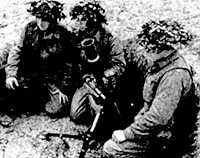 A Warning: This is intended to be a controversial article.
A Warning: This is intended to be a controversial article.
Modern Wargamers tend to find that tanks dominate the Wargames table to the detriment of infantry incarcerated in APC's or cowering in houses, trenchs etc. The anomalies of the wargames table -- the all seeing eye of the wargamer especially -- are more of a problem for Modern Wargamers; in modern warfare concealment is a premium.
For this reason it is more important that infantry are made as effective as possible by giving them the optimum Organisation. Rifles are still the main weapon of the infantry and for this reason the beat Organisation is I feel as follows:
- Coy HQ: Coy Commander; C.S.M.; Radio
1st Rifle Pltn:Platoon Commander; 2 S.M.Gs; (1 is Pltn Sgt); 6 Riflemen; 1 or 2 L.M.
2nd Rifle Pltn: Platoon Commander; 2 S.M.Gs; (1 is Pltn Sgt); 6 Riflemen; 1 or 2 L.M.
3rd Rifle Pltn: Platoon Commander; 2 S.M.Gs; (1 is Pltn Sgt); 6 Riflemen; 1 or 2 L.M.
(4th Rifle Pltn: In WWII German Army)
Support Pltn: 2 x Light Mortars (50mm or 2in) and 2 x Bazookas.
This organisation gives a relatively large number of riflemen in relation to support weapons (Mortars and rocket launchers). While not excluding support weapons it does not give a top heavy Organisation. Many wargamers use a small company as follows:
- Company Commander
C.S.N
Radio Op.
2 LMGs
1 Rocket Launcher
5 Riflemen or SMGs
This organisation is what I would call top heavy - it has too many men who are not riflemen, and is in addition too small to be called a Company. It cannot carry out the company's role -- it is a over supported platoon.
Once Organisation has been initially decided tactics have to be considered. In no other period are the role and use of small units of such importance. This is because it is all too easy to use platoons and companies in the way companies and battalions are used in Horse and Musket battles i.e. they form lines and advance across open ground straight at the enemy.
An understanding of tactics is vital. Two points must be held in mind:
- (1) concealment as mentioned is vital (human wave tactics rarely employed charges longer
than 25 yards)
(2) Fire and Movement is the vital principle of modern warfare in particular.
The fire fight is essential in modern war, and must be won before action can be considered. For this reason rifles are important: support weapons are as their name would suggest merely for support - rifles are for direct fire, added by Assault Rifles or LMGs. Once won the upper hand must be maintained; for this reason fire and movement is vital.
Concealment is the major problem since the wargamer peers down from a great height with an all seeing eye. While impossible to prevent this it is possible to stick to true tactics and evolve rules for fire fights etc. To enable decent length of action I keep casualties to the absolute minimum -- otherwise units tend to be massacred in no time at all. Secondly I take account of their cover. Once the fire fight is won -- the side with the highest morale and dice score wins - they have to maintain upper hand by using two firing groups i.e. on platoon level LMG/S and Riflemen or Company level 2 platoons.
Only during actual final dash at enemy when attackers are in open are casualties caused at a greater rate. To help in clearing obstacles and, in defence, to kelp in creating defensive positions a platoon of combat engineers in attached to the Battalion HQ. (organised as infantry platoon and capable of combat as in the German Army in the last war).
In my wargames, because I consider infantry to be the arm on which a decision most often rests as in the 2nd World War, I usually use a task force of Infantry Battalion supported b., Armoured Company and Artillery Battery. This way tanks do not dominate. The only way to achieve realism is to have small actions at not above battalion level. Using larger units makes for unrealistic action because, call them what you will, battalions or regiments, they are still companies and platoons. It in these two units that are vital in modern infantry combat.
Small units actions; deep understanding of problems and tactics of modern war and finally the best organisation to achieve realism are the three factors in modern infantry in wargames.
Modern Infantry in Wargames: Reader Feedback
Back to Table of Contents -- Wargamer's Newsletter # 102
To Wargamer's Newsletter List of Issues
To MagWeb Master Magazine List
© Copyright 1970 by Donald Featherstone.
This article appears in MagWeb.com (Magazine Web) on the Internet World Wide Web.
Other articles from military history and related magazines are available at http://www.magweb.com